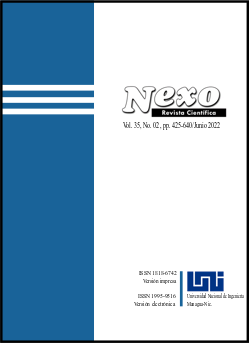Influencia de las condiciones de activacion sobre la resistencia a la compresión, microestructura y productos de reacción de cementos de ceniza de bagazo de caña de azúcar
DOI:
https://doi.org/10.5377/nexo.v35i02.14624Palabras clave:
cemento activado con álcalis, ceniza de bagazo de caña de azúcar, cemento de aluminato de calcio, resistencia a compresión, microestructura, productos de reacciónResumen
Pastas de ceniza de bagazo de caña de azúcar (CBCA) y cemento de aluminato de calcio (CAC) fueron activadas con soluciones de silicato de sodio, variando el contenido de CBCA (80-95 % en peso), la relación SiO2/Na2O (8-14 % en peso respecto al peso de CBCA), y la temperatura de curado (20 y 40 ºC o 100 y 200 ºC). Se obtuvieron resistencias a la compresión a los 28 días entre 5-20 MPa. Los resultados son cercanos a los reportados en la literatura para pastas de CBCA/metacaolin. En general, se observó que la resistencia a la compresión disminuyó con el aumento de la temperatura de curado de 100 a 200 ºC. La ganancia en la resistencia a la compresión se atribuyó a la formación de una matriz densa de productos de reacción amorfa como C-S-H, N-A-S-H, C-A-S-H o gel de sílice. Nuestros resultados enfatizan la posibilidad de utilizar mayores contenidos de ceniza de bagazo de caña de azúcar para obtener cemento activado con álcali con resistencias a la compresión de hasta 20 MPa. Actualmente se está trabajando más para identificar el efecto de algunas variables en la resistencia a la compresión de los materiales compósitos.
Descargas
1330
Descargas
Publicado
Cómo citar
Número
Sección
Licencia
Derechos de autor 2022 Universidad Nacional de Ingeniería

Esta obra está bajo una licencia internacional Creative Commons Atribución 4.0.
Los autores que publican en Nexo Revista Científica están de acuerdo con los siguientes términos:
- Los autores conservan los derechos de autor y conceden a la revista el derecho de la primera publicación bajo la licencia Creative Commons Attribution License, que permite a otros compartir el trabajo con un reconocimiento a la autoría de la obra y a la publicación inicial en Nexo Revista Científica.
- Los autores pueden establecer por separado acuerdos adicionales para la distribución no exclusiva de la versión de la obra publicada en la revista (por ejemplo, en un repositorio institucional o en un libro) con el reconocimiento de su publicación inicial en Nexo Revista Científica.
- Se permite y se anima a los autores a difundir sus trabajos electrónicamente (por ejemplo, en repositorios institucionales o en su propio sitio web) antes y durante el proceso de envío, ya que puede dar lugar a intercambios productivos, así como a una citación más temprana y mayor de los trabajos publicados.










